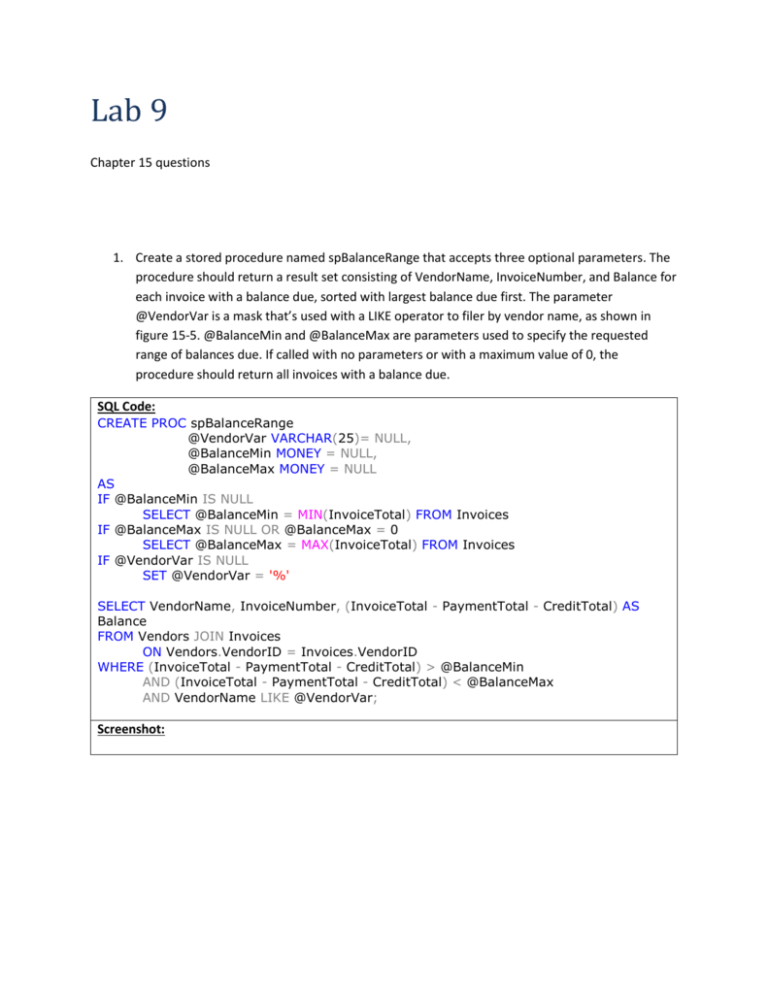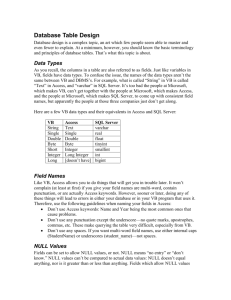SQL Stored Procedures Lab: Vendor Invoices & Balances
advertisement

Lab 9 Chapter 15 questions 1. Create a stored procedure named spBalanceRange that accepts three optional parameters. The procedure should return a result set consisting of VendorName, InvoiceNumber, and Balance for each invoice with a balance due, sorted with largest balance due first. The parameter @VendorVar is a mask that’s used with a LIKE operator to filer by vendor name, as shown in figure 15-5. @BalanceMin and @BalanceMax are parameters used to specify the requested range of balances due. If called with no parameters or with a maximum value of 0, the procedure should return all invoices with a balance due. SQL Code: CREATE PROC spBalanceRange @VendorVar VARCHAR(25)= NULL, @BalanceMin MONEY = NULL, @BalanceMax MONEY = NULL AS IF @BalanceMin IS NULL SELECT @BalanceMin = MIN(InvoiceTotal) FROM Invoices IF @BalanceMax IS NULL OR @BalanceMax = 0 SELECT @BalanceMax = MAX(InvoiceTotal) FROM Invoices IF @VendorVar IS NULL SET @VendorVar = '%' SELECT VendorName, InvoiceNumber, (InvoiceTotal - PaymentTotal - CreditTotal) AS Balance FROM Vendors JOIN Invoices ON Vendors.VendorID = Invoices.VendorID WHERE (InvoiceTotal - PaymentTotal - CreditTotal) > @BalanceMin AND (InvoiceTotal - PaymentTotal - CreditTotal) < @BalanceMax AND VendorName LIKE @VendorVar; Screenshot: 2. Code a call to the procedure created in exercise 1 Passed by position with @VendorVar=’M%’ and no balance range. SQL Code: EXEC spBalanceRange 'M%'; Screenshot: 3. Code a call to the procedure created in exercise 1 Passed by name with @VendorVar omitted and a balance range from $200 to $1000. SQL Code: EXEC spBalanceRange @BalanceMin = '$200', @BalanceMax = '$1000'; Screenshot: 4. Code a call to the procedure created in exercise 1 Passed by position with a balance due that’s less than $200 filtering for vendors whose names begin with C or F. SQL Code: EXEC spBalanceRange [F% C%], '$200'; Screenshot: 5. Create a stored procedure named spDateRange that accepts two parameters, @DateMin and @DateMax, with data type varchar and default value null. If called with no parameters or with null values, raise an error that describes the problem. If called with non-null values, validate the parameters. Test that the literal strings are valid dates and test that @DateMin is earlier than @DateMax. If the parameters are valid, return a result set that includes the InvoiceNumber, InvoiceDate, InvoiceTotal, and Balance for each invoice for which the InvoiceDate is within the date range, sorted with earliest invoice first. SQL Code: CREATE PROC spDateRange @DateMin VARCHAR(20)= NULL, @DateMax VARCHAR(20)= NULL AS IF @DateMin IS NULL THROW 50001, 'Minimum Date Left Blank', 1; IF @DateMax IS NULL THROW 50002, 'Maximum Date Left Blank', 1; IF ISDATE(@DateMin) = 0 THROW 50003, 'Minimum is not a valid date', 1; IF ISDATE(@datemax) = 0 THROW 50004, 'Maximum is not a valid date', 1; IF (SELECT CONVERT(DATETIME, @DateMin)) > (SELECT CONVERT(DATETIME, @datemax)) THROW 50005, 'Min date is greater than max date', 1; SELECT InvoiceNumber, InvoiceDate, InvoiceTotal, (InvoiceTotal - CreditTotal - PaymentTotal) AS Balance FROM Invoices WHERE InvoiceDate > CONVERT(DATETIME,@DateMin) AND InvoiceDate < CONVERT(DATETIME,@DateMax) ORDER BY InvoiceDate DESC; Screenshot: 6. Code a call to the stored procedure in exercise 5 that returns invoices with an InvoiceDate between December 10 and December 20, 2011. This call should also catch any errors that are raised by the procedure and print the error number and description. SQL Code: EXEC spDateRange '2011-12-10', '2011-12-20'; Screenshot:







![[#EL_SPEC-9] ELProcessor.defineFunction methods do not check](http://s3.studylib.net/store/data/005848280_1-babb03fc8c5f96bb0b68801af4f0485e-300x300.png)
![[#CDV-1051] TCObjectPhysical.literalValueChanged() methods call](http://s3.studylib.net/store/data/005848283_1-7ce297e9b7f9355ba466892dc6aee789-300x300.png)